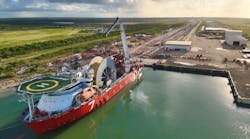Don W. Allen
VIV Solutions Inc.
Stergios Liapis
Shell Exploration and Production
Vibration insubsea risers caused by vortex shedding is a challenge to operations in deepwater. Proper management of vortex induced vibration (VIV) requires a balance between acceptable movement and the cost of suppression. To address the questions involved in planning configurations for marine risers, and to investigate the impacts of typical conditions affecting VIV, two programs were conducted consisting of tests along a tubular (just under 100 ft long) that was towed under a rotating arm at high speeds to simulate conditions similar to those a deepwater riser may encounter.
The test results reveal a number of phenomena regarding the performance of helical strakes. Among the most important are:
- While strakes provide significant additional damping, they offer the most benefit when placed at locations corresponding to the maximum velocities encountered by the tubular
- Strakes placed at low velocity locations, at the expense of high velocity locations, still contribute to VIV suppression but mostly by adding damping
- It is not critical to cover 100% of each joint or region (i.e. 100% density) though suppression performance improves with increased coverage density
- While strake alignment is desirable, it may often be unnecessary since the degradation in strake performance from misalignment can be fairly small
- Relatively low to moderate amounts of uniform marine growth cause very little degradation in strake performance of an isolated tubular (this is not necessarily true of tandem tubulars or arrays)
- For triple start strakes with a fin height of 0.25D, pitch lengths of both 12D and 17.5D were quite effective with only small differences in their performance, thereby indicating that strake performance is relatively insensitive to pitch lengths in the range of about 12D to 18D
- Strakes increase drag above that of a bare cylinder.
All of the experiments were conducted in the Rotating Arm Basin at the Naval Surface Warfare Center in Carderock, Maryland. The basin is a circular indoor basin approximately 260 ft (79 m) in diameter and 20 ft (6 m) deep. Models are towed in circular paths through still water by a rotating arm. A 2.5-in. (6.3-cm) diameter test pipe was placed under the arm, supported by a truss assembly, for these tests.
The test pipes at each end were supported by an assembly that allowed the ends to rotate while allowing the test pipes to be pre-tensioned the same value. However, the variation of drag on the various models tested produced different tensions during testing. The tensions were measured at each end and the accelerations were measured at four locations along the pipe axis.
Aluminum connectors were made to fit inside the main joints (as an inner sleeve) and bolted to the fiberglass to connect adjacent joints. Helical strakes were modeled by gluing strips of Buna-n rubber onto the pipe surface. The strake cross-sections were rectangular, ranging from a base width to height ratio of 0.85 to1.0 (square) with most of the cross-sections square.
For these experiments, the rotation of the arm ensures that the test cylinder experiences higher velocity at the outer end than at the inner end. This means that the vortex shedding frequencies are higher at the outer end than at the inner end since vortex shedding frequencies are proportional to velocity. Since the fundamental natural frequency in bending for a long tubular is relatively low, there is a range of bending modes that may be experienced by the test cylinder (these modes are typically categorized as those that are in-line with the flow and those that are transverse to the flow; however, the primary focus here is on the transverse bending modes since those modes usually cause the largest fatigue damage and respond with larger displacements than the in-line modes). The relative flow at the outer end of the test cylinder excites higher modes than the relative flow at the inner end of the cylinder.
Deepwater ocean tubulars can experience a similar phenomenon due to changes in ocean current magnitude with depth.
It is important to understand this concept since a vortex suppression device will only suppress vortex shedding excitation locally. The response modes and frequencies are further complicated because helical strakes not only change the cylinder vibration amplitude but they can, and usually do, also change the cylinder vibration response frequency (frv). An effective helical strake will reduce frv, which can thereby reduce the vibration mode and the bending stress on the cylinder. Thus, effective helical strakes can improve the fatigue life of the cylinder in two ways: By reducing the response amplitude; and by reducing the response frequency.
Displaying 1/3 Page 1,2, 3Next>
View Article as Single page






